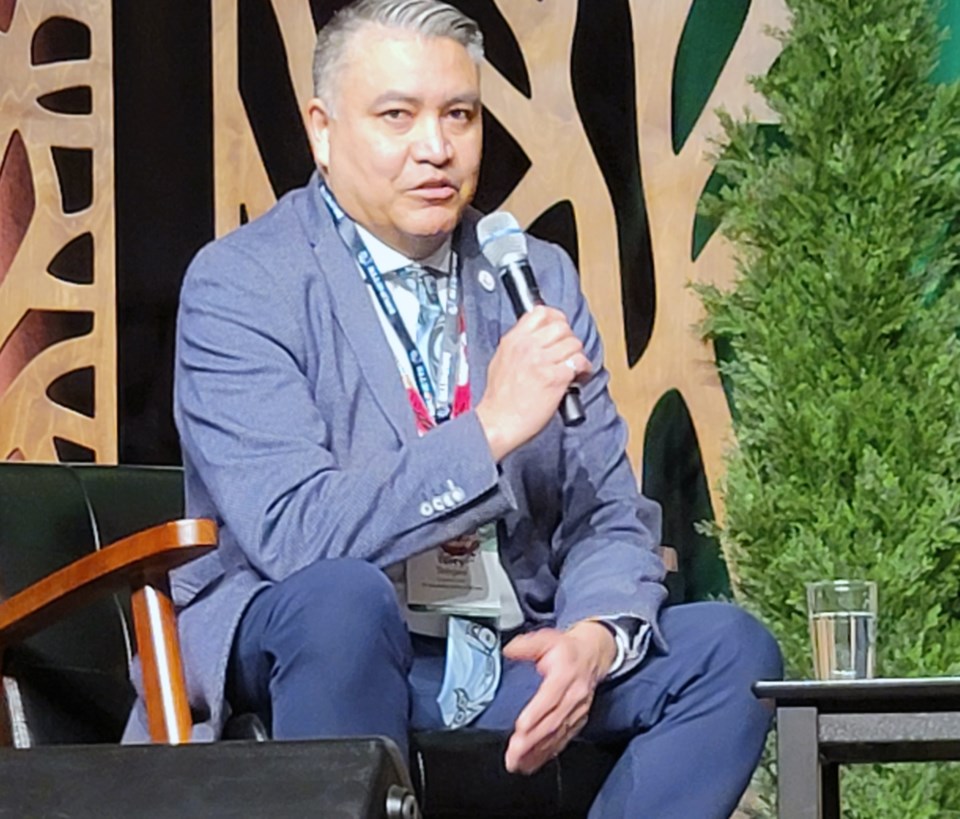Terry Teegee can sympathize with the Mackenzie mayor Joan Atkinson when she watches truckloads of harvested trees bypassing her northern B.C. town and its shuttered mills.
The regional chief of the B.C. Assembly of First Nations is in agreement with Atkinson in her belief that perhaps there is a better way to keep people working in the forest industry by giving smaller communities the right to process Crown timber in the same region where it was logged.
“Over 20 years ago appurtenancy was taken away from small communities so you were no longer required to process that wood into places like Mackenzie and that allowed many industries to access timber that was a lot further away, “ said Teegee, who spoke Thursday morning at the B.C. Council of First Nations convention in Prince George.
“Maybe there is an opportunity to have local First Nations and communities to develop a partnership or a relationship to have some sort of manufacturing or use existing manufacturing in Mackenzie to utilize the timber locally and therefore the benefits stay in that community. That’s a huge challenge for some of the mayors in the small communities, but First Nations are neighbours and we’re not going anywhere.”
As the only province in Canada to adopt the United Nations Declaration on the Right of Indigenous Peoples, Teegee says B.C. is a test case for the rest of the country, a formal recognition of the rights of Indigenous people to govern themselves. Part of that agreement is restoring the right of First Nations to have a say in the management of their forests and granting Indigenous groups tenure rights to log their own forests.
He pointed to communities like Prince George, Fort St. James and Chetwynd that depend on their mills as the major employer are how they are susceptible to trends in the market and fluctuating prices for wood products, which forces the hand of the major corporations that own and operate those mills when it becomes less profitable to keep those mills running at capacity.
“Some First Nations in smaller communities are completely dependent of one corporation that owns the tenure and they make decisions somewhere else,” he said. “Their interest is in the bottom line to shut it down. You see it in mining as well and there are repercussions. There’s hundreds of employees here in Prince George who are eventually going to lose their jobs because of the decisions that were made. Perhaps there is a better way, if the decisions are made locally, and if there is interest locally.”
In the first year after UNDRIP became law in 2019, Teegee was disappointed in the slow process of implementation of the new policy. But he has seen successes, like the government’s rejection of the proposed Sunkunka coal mine on the Blueberry First Nations land in the Peace River region largely because of potential detrimental effects on caribou herds.
He says progress has been made to involve First Nations in the Emergency Program Act to allow Indigenous governments to implement their own ways of dealing with emergency like wildfires and flood. He also said there’s been positive jurisdictional changes that give First Nations more of say in child welfare decisions.
“British Columbia jumped in with two feet and there’s other provinces dead set against UNDRIP, but there are other provinces looking at what’s happening here,” Teegee said. “Nothing good comes easy and ultimately, we’re not going backwards and I think the change is for the positive.”
In forestry, where Indigenous forest tenure in B.C. once stood at 11.6 per cent in 2017, the goal of UNDRIP is to allow as much as 30 per cent of that control to First Nations. The government now has the right to block tenure transfers between companies that are not in the public interest, which could benefit First Nations.
“What UNDRIP has done was really open the opportunity to start the conversation, which began with the Truth and Reconciliation Commission and if you keep adding to the conversation it will perhaps create better and stronger relationships,” Teegee said.
“We have 204 First Nations communities in British Columbia and there’s competing interests and shared territories and overlap and those need to be worked out internally with our Indigenous people. But I think ultimately, whether it’s 30 percent or 50 per cent, what we currently get now is clearly not enough.”


